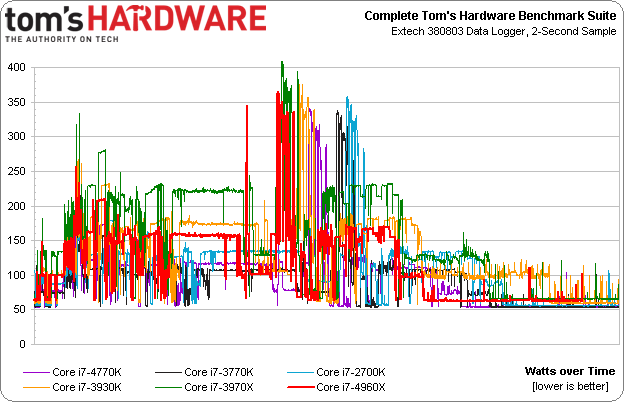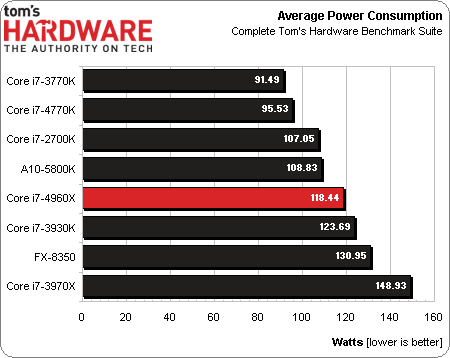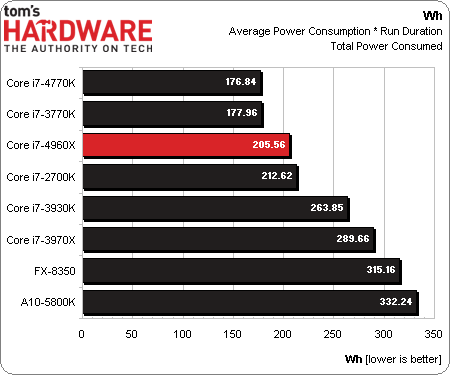Intel Core i7-4960X Review: Ivy Bridge-E, Benchmarked
Power Consumption, Ivy Bridge-E’s Big Surprise
Alright, so, overall I have to admit that those benchmarks were pretty boring. I sort of thought that might turn out to be the case when I heard that Ivy Bridge-E would be roughly the same six-core configuration, updated with a lightly-tuned architecture.
But, like all of the other processor reviews I work on, I made it a point to log power consumption as our scripted suite ran. I didn’t expect the results to be particularly noteworthy—after all, Intel is saying that Core i7-4960X has the same 130 W TDP as the Core i7-3930K.
In the chart above, data points are recorded every two seconds, and the end of the run is truncated to fit as much information as possible in the space available. Regardless of where each CPU seems to finish the complete suite, 30 minutes of idle time are tacked onto the end before our script automatically shuts the systems down. As a result, the average and total efficiency measurements include a long period of time where absolutely nothing is happening.
Without question, Core i7-4960X is more power-friendly than the 150 W Core i7-3970X, seen in green. But even the Core i7-3930K (in yellow) appears to register higher energy use during our suite.
To get a better idea of what the line graph really means, we average each processor’s results from the time we start the test until our log shows zero power use.
The system averages for each setup fall almost exactly where they should. The 77 and 84 W Ivy Bridge and Haswell CPUs drive the machines averaging the least power consumption. The 95 W Core i7-2700K and 100 W A10-5800K place third and fourth. Intel’s 130 W Core i7-3930K and -4960X take the next two spots, followed by AMD’s 125 W FX-8350 (which should probably be in front of the LGA 2011-based parts). Finally, Core i7-3970X lands in the back, swinging its sweaty 150 W TDP around.
Of course, the -3970X uses that big power budget to get things done faster. Let’s multiply the time it takes to cruise through our suite by average power use to give us efficiency in Wh.
Get Tom's Hardware's best news and in-depth reviews, straight to your inbox.
Crazy, right? We already know that the Core i7-3970X is fast. But it needs so much power to get there that the Sandy Bridge-E processor isn’t very efficient in the process. Only AMD’s FX-8350 and A10-5800K use more energy getting through our benchmark suite.
The average consumption numbers showed us that Intel’s Core i7-3930K uses a lot less power than the flagship model, but is so much slower as a result of its cut-back shared L3 cache and lower frequency that it, too, ends up less efficient than Ivy Bridge-E. Even the Core i7-2700K shows up behind the Core i7-4960X.
It’d be almost impossible for the six-core -4960X to outperform Intel’s latest quad-core parts decisively enough to beat them in an efficiency race. But despite the single-threaded apps and half-hour idle period added to our log, Ivy Bridge-E does remarkably well.
Current page: Power Consumption, Ivy Bridge-E’s Big Surprise
Prev Page Results: Media Encoding Next Page Is Ivy Bridge-E An Enthusiast’s Salvation?-
Someone Somewhere Probably would have been nice to be 8-core. Isn't the actual die on these things just a cut-down 12-core chip? Think I read that somewhere.Reply
EDIT: Minor error:
surface alongside Haswell-based 9-series chipsets
Shouldn't that be Broadwell? -
designasaurus There's a rumor going around that Ivy-E is going to have a soldered heatspreader instead of using thermal paste. Obviously this would be a big differentiator for enthusiasts picking between Haswell and Ivy-E. Given your access to Ivy-E, do you guys at Tom's have any opinions on this rumor?Reply -
killerchickens I bet it overclocks like a beast. :)Reply
Lol now time to spend $1000 to save on my power bill. -
ingtar33 about all i'd expect. shame really, but it looks like the enthusiast market is at a standstill till AMD starts to compete again.Reply -
sna too early to judge...Reply
The 6 cores ivyBridge-e "K" version is the real thing.
and I dont get it , how Tomshardwae fails to say about the SandyBridge-e not having PCIE 3.0 support , while the ivy-E has PCIe 3.0 support . this is a Big factor here. -
ingtar33 Reply11172422 said:too early to judge...
The 6 cores ivyBridge-e "K" version is the real thing.
and I dont get it , how Tomshardwae fails to say about the SandyBridge-e not having PCIE 3.0 support , while the ivy-E has PCIe 3.0 support . this is a Big factor here.
they did say it. You didn't read the beginning of the review. Of course pci-e 3.0 is a gimmick and not a reason to buy a new 2011 mb and ib-e chip... and it will remain a marketing gimmick untill gpus can actually be bottlenecked by pci-e 2.0 x16... high end gpus barely bottleneck on pci-e 2.0 x8 atm... it will be a little while (another generation or 3) before gpus will NEED pci-e 3.0.
-
Someone Somewhere Replyofficial PCI Express 3.0 compliance (remember, Sandy Bridge-E only claimed 8 GT/s signaling support), and 22 nm manufacturing.
That's pretty much saying it did it unofficially.
Besides, you have to look hard to find something bottlenecked by PCIe2.0x8; even high-end GPUs won't run into bandwidth limitations. -
CommentariesAnd More WOW !!!!!!! So Intel is expecting someone to spend another 1000 bucks just for a 10-20% boost. Yay!!!!!!!! This is Ivy Bridge-E. I am getting it , YAY!!!!!!!!!!!!!Reply -
shin0bi272 still no gaming benchmarks eh? I guess I'll save my money and stick with my i7-920 for a little bit longer.Reply



